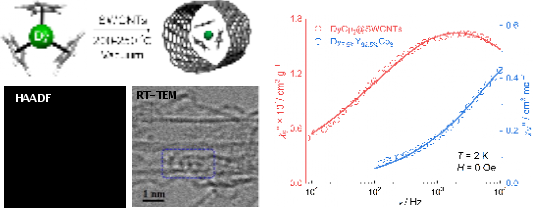Single-molecule magnets (SMMs), as nano-objects possessing magnetic bistability characteristics, are promising to be the basic structural units for the next generation of high-density registers or quantum information processing. With the discovery of various types of organometallic lanthanide-based single-molecule magnets in recent years, their high blocking temperatures and sizable spin relaxation times make them the most promising cases for application. However, such single-molecule magnets tend to be unusually sensitive to oxygen and moisture, greatly restricting the path to device realization.
Masahiro Yamashita's group at the School of Chemical Science and Engineering, Tongji University, reports a case where air-sensitive organometallic single-molecule magnet DyCp3 (Cp− = cyclopentadienyl) was protected using single-walled carbon nanotubes (SWCNTs). The complex DyCp3@SWCNTs has good water-oxygen tolerance. Compared with the diluted sample Dy7.5%Y92.5%Cp3, the AC magnetic induction intensity of the complex at zero field shows an obvious AC frequency dependence, indicating that the slow magnetic relaxation property of the guest molecule has been preserved, which provides a new direction for the development of devices for this type of air-sensitive molecules. The related result “First Encapsulation of Organometallic Single-Molecule Magnet into Single-Walled Carbon Nanotubes” was published in Angew. Chem. Int. Ed.

The team confirmed the success of the encapsulation using double-aberration corrected transmission electron microscopy (TEM). Due to the high electron scattering ability of dysprosium atoms, they show up as white bright spots in scanning mode in high angle annular dark field imaging (HAADF) and dark shadows in transmission mode. The similarity between quasi-1D DyCp3 arrays captured using real-time TEM (RT-TEM) and simulated images supports these conclusions.

Due to lack of crystallinity of the complex and the susceptibility of organic molecules to e-induced polymerization reactions under electron beam conditions, the structural details of the guest molecules cannot be directly probed using conventional X-ray or electron diffraction. Therefore, X-ray absorption fine structure (XAFS) and X-ray photoelectron spectroscopy (XPS) have been used to demonstrate the integrity of DyCp3 molecules after encapsulation. And the possible arrangement structure of DyCp3 molecules inside SWCNT was optimized using density-functional theory (DFT). The magnetic anisotropy of the DyCp3 molecule after encapsulation was calculated from the complete active space self-consistent field (CASSCF).
This work verifies the protective effect of single-walled carbon nanotube on organometallic single-molecule magnets, expanding the latter's application scenarios; it also demonstrates the magnetic characteristics of low-dimensional nanomagnets in confined space that distinguish them from those in the crystalline state.
Dr. Haitao Zhang, Dr. Yoji Horii and Prof. Dr. Masahiro Yamashita are the co-corresponding authors of the paper. The above research work was supported by the National Natural Science Foundation of China and others.
The thesis links: https://onlinelibrary.wiley.com/doi/10.1002/anie.202503979